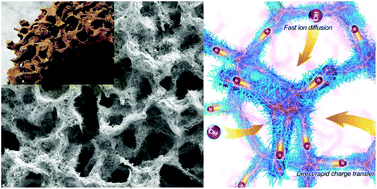NiMoO4 nanorod deposited carbon sponges with ant-nest-like interior channels for high-performance pseudocapacitors†
Abstract
The mounting challenges of global energy shortage and climate change call for the development of low-cost and high performance energy storage systems. Here, we propose the facile preparation of a 3D sponge electrode material by the uniform deposition of NiMoO4 nanorods on a carbonized melamine sponge (CMS) during a solvothermal reaction. Under the templating of a macroporous CMS backbone, the obtained 3D hierarchical NiMoO4/CMS composite sponge can offer numerous electrochemical sites for faradaic redox reactions and also provide interconnected conducting carbon networks for direct and rapid charge transfer. Particularly, the unique ant-nest-like interior channels in the NiMoO4/CMS composite sponge can ensure fast ion transportation and also buffer the volume change of NiMoO4 during the long-term cycling. Benefiting from these advantages, the NiMoO4/CMS composite electrode exhibits a high specific capacitance of 1689 F g−1 at 1 A g−1, which outperforms most of the previously reported NiMoO4-based electrodes. Moreover, the asymmetric supercapacitor device fabricated utilizing the composite sponge as a binder-free positive electrode also delivers a superior cycling stability (91.9% capacity retention after 2500 cycles) and a high energy density of 48.8 W h kg−1 at a power density of 800 W kg−1. Hence, the current study provides a new protocol for the low-cost fabrication of 3D sponge-like electrodes towards practical supercapacitor applications.



 Please wait while we load your content...
Please wait while we load your content...